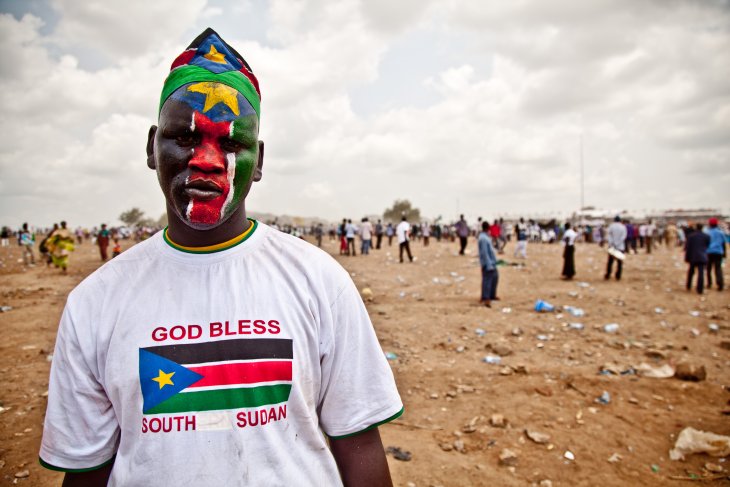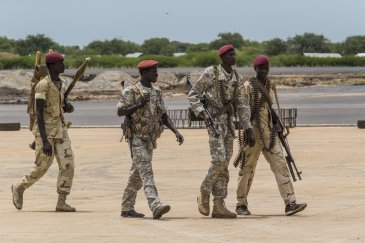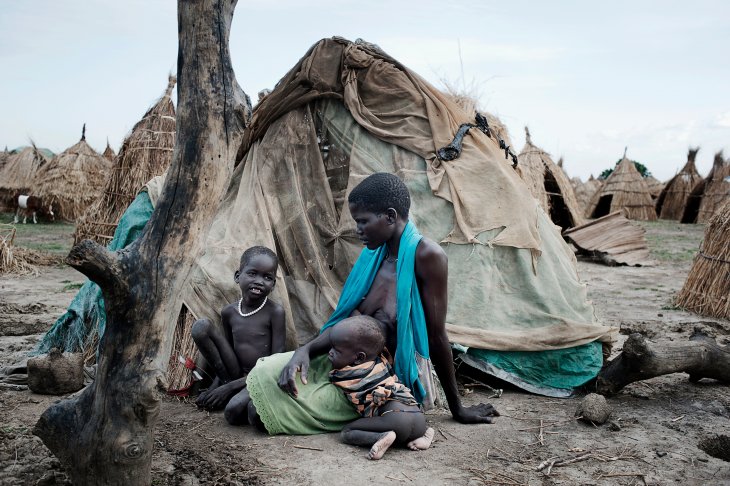
Photo: ENOUGH Project/Flickr
Note to the reader: This blog post is intended for readers who desire a short introduction to current affairs in South Sudan. The text is an adaptation of a brief originally written in Norwegian and titled “Sør-Sudan: fra fest til katastrofe”. That brief is intended for a secondary school audience and was published in May 2017 by the Norwegian Institute of International Affairs. In the interest of inclusiveness some nuance has been dispensed of; more comprehensive coverage may be found in the list of further reading at the end of the blog post.
South Sudan marked its independence from Sudan in July 2011 with public celebrations in which celebrities and heads of state from all over the world participated. But despite great optimism and international support, by December 2013 the country had already reverted to civil war. Since then an ever-widening conflict marked by broken promises and failed peace agreements has brought the world’s youngest nation into deep political crisis, economic collapse and humanitarian catastrophe.
Background to the conflict
At the beginning of the 19th century, the Ottoman Empire united and colonised the regions around the upper stretches of the Nile. The colony, which came to be known as Sudan, included modern South Sudan. In 1899, Sudan came under the rule of the Anglo-Egyptian Condominium, and in 1956 it gained independence. Political unrest, disagreements and violence led subsequently to civil war in Sudan’s southern provinces, where various rebel movements fought for independence between 1963 and 1972.
Thereafter a new, more extensive civil war broke out in 1983. It lasted for over 20 years, causing enormous suffering and many deaths. It ended in 2005 with the Comprehensive Peace Agreement between the Government of Sudan in the capital Khartoum and the rebel group Sudan People’s Liberation Movement/Army (SPLM/A) in the south. The agreement provided for a referendum on independence, which was held in January 2011. Southerners voted overwhelmingly (98.8 percent) for independence from Sudan, and Africa’s 54th state was founded on 9 July.
Commentators feared that tensions between the north and south would undermine the newly won peace. But the greatest threat proved to be internal political conflicts within South Sudan. Despite its militarised and authoritarian nature, the South Sudanese government was weak and exercised only limited control over the new nation. Previously, the struggle against the government in the north had helped unite southerners, but instead independence led to a rise in internal discontent in the south. Rivalry within the SPLM escalated in 2013. At the centre of this political storm were President Salva Kiir and Vice-President Riek Machar, who had been deadly enemies at times during the previous civil war.
In June 2013, Salva Kiir dismissed Riek Machar along with the rest of his cabinet. In the following months, the political conflict between the two factions intensified and on 15 December violent conflict broke out in the capital Juba between soldiers loyal to the president and soldiers loyal to Riek Machar.
Civil war in South Sudan
Commentators in the media and elsewhere who attempt to explain the ongoing crisis often focus on supposed “deep-rooted divisions” between the country’s many ethnic groups and on the personal rivalry between Salva Kiir and Riek Machar. In particular, commentators tend to focus on divisions between the two largest people, the Dinka and the Nuer. However, we believe this approach is based on a misunderstanding of what lies at the heart of the conflict and the underlying factors that are driving it.
This has made it difficult to establish a shared national identity and has instead contributed to fragmenting the South Sudanese society and the civil war has exacerbated these destructive tendencies.An authoritarian tradition of governance inherited from the colonial era, a lack of education among the general population, and an uncontrolled rumour mill boosted by social media, make it easy for the country’s elites to mobilize political support along territorial and ethnic lines in their battle for power, resources and influence.
Salva Kiir and Riek Machar are largely the frontmen for pragmatic alliances and various powerful networks wherein support and loyalty can be bought and sold. Accordingly they have limited personal power and few opportunities to act independently of a political system and allocation of resources that benefits the interests of their own networks.
In the days and weeks after fighting broke out in Juba in December 2013, military leaders, politicians and local youth escalated the conflict, and the violence spread to large parts of the three states of Jonglei, Unity and Upper Nile. The government’s SPLA forces under Salva Kiir, and the so-called SPLA In Opposition (SPLA-IO), led by Riek Machar, quickly appointed themselves as the two main armed factions in the conflict.
The war continued despite several rounds of negotiation, including several agreements on the cessation of hostilities and an agreement to resolve the split within the SPLM party that was signed in Arusha (Tanzania) in January 2015.

Photo: UNMISS/Isaac Billy/Flickr
After further negotiations under international pressure and threats of sanctions from the international community, many people felt that the parties had achieved a breakthrough when a peace agreement was signed in August 2015. But the fragile agreement was based on unwillingly-extracted compromises and a power sharing agreement between the two leaders that would prove difficult to implement in practice.
Over the ensuing days, heavy fighting continued between government and opposition forces, and the city was gripped by chaos and lawlessness. Soldiers looted shops and killed and raped civilians, while the peacekeeping forces were passive bystanders. At least 36,000 people fled, and around 300 were killed in the fighting. The situation in Juba caused outbreaks of violence in other parts of South Sudan. When the fighting subsided three days later, the basis for the August 2015 peace deal was shattered. The government forces had control over Juba, while Machar and his forces fled towards the border with the Democratic Republic of the Congo (DRC).
The parties dragged out implementation of the peace agreement, but finally in April 2016, Riek Machar returned to Juba and was reinstated as Vice-President. In the ensuing months, tensions increased in the capital as the parties experienced problems in working together, and skirmishes between military units increased in frequency. The reason for this increasing insecurity was that, in contravention of the August 2015 agreement, Juba had not been demilitarised. In addition, international observers and peacekeeping forces (UNMISS) lacked both the power and an adequate mandate to keep the parties’ soldiers in check. On 8 July, while Salva Kiir and Riek Machar were meeting in the presidential palace, soldiers started shooting at each other right outside.
South Sudan today
The conflict in Sudan has escalated since July 2016. At the start of the civil war, the conflict was limited mainly to the three states in the north-east of the country, a region known as the Greater Upper Nile. Since July 2016, the fighting has spread to new areas and now affects eight of South Sudan’s 10 states, with skirmishes occurring on a weekly basis. At the same time, the overall picture continues to be highly complex and in a constant state of change with the formation of small, new, local armed groups. The result is a fragmented and unpredictable conflict situation with weakened lines of command, where soldiers and small units can operate more-or-less independently. This makes a lasting ceasefire difficult to achieve.
Meanwhile, the main parties in the civil war are accused of committing gruesome war crimes, including the use of child soldiers and large-scale sexual violence. The UN and other international actors also report ethnically motivated hate rhetoric and situations resembling genocide, with civilians and soldiers alike being killed allegedly for belonging to particular ethnic groups.

Photo: World Humanitarian Summit/Flickr
A woman and her children who had to flee following clashes in Bentiu, Unity State
The peace agreement of August 2015 has to all intents and purposes collapsed, and there is little to suggest that the warring parties wish to enter into sincere negotiations any time soon. In December 2016, the government initiated a so-called national dialogue involving peace and reconciliation talks at local, regional and national levels. The stated intention is to help build a national identity. But unless the rebels are included, and without a break in the fighting, it is unlikely that this initiative will have an effect.
The economic situation in South Sudan continues to worsen. For revenue the state relies mainly on the production and export of oil. Production has now fallen sharply because of the civil war. In addition, revenues from oil exports have declined drastically as a result of the dramatic fall in oil prices in 2014. This has crippled the national economy. The South Sudanese Pound (SSP) is falling in value. In 2012, one US dollar was equivalent to approximately SSP 3.8. In April 2017, one US dollar was equivalent to SSP 146. This has meant a dramatic rise in the price of imports. The prices of basic goods and other foodstuffs are rising and exacerbating the country’s humanitarian catastrophe.
The economic crisis is also significantly curtailing the government’s political room for manoeuvre. To pay wages and keep its military machine running, the government is using future oil revenues as collateral for new loans. The army is also in danger of collapse. Without money it is difficult to maintain alliances with local warlords and militia groups. This may cause these local units to look out for their own interests and switch their loyalties against the government.
South Sudan is experiencing a deep humanitarian crisis. The civil war is in its fourth year. It has caused thousands of deaths; 1.8 million people have fled to neighbouring countries; and nearly two million people are internally displaced. In 2017 the situation in two districts in South Sudan had become so serious that the UN declared a famine, for the first time in six years. Most likely there are several other areas in the country that are equally affected by food-shortages. While humanitarian needs are rising, the work of aid organizations, including Norwegian People’s Help and the Norwegian Refugee Council, is coming under ever greater pressure. The conflict is making it increasingly difficult and hazardous for them to operate in the country and reach famine-affected areas. According to the UN, 82 aid workers have been killed since the conflict started in 2013, including two employees of Norwegian People’s Aid.
Further reading:
- Alex de Waal (2014) When kleptocracy becomes insolvent: Brute causes of the civil war in South Sudan. African Affairs 113 (452): 347-369
- Øystein H. Rolandsen (2015) Another civil war in South Sudan: the failure of Guerrilla Government? Journal of Eastern African Studies 9(1): 163–174.
- Øystein H. Rolandsen; Helene Molteberg Glomnes; Sebabatso Manoeli & Fanny Nicolaisen (2015) A year of South Sudan’s third civil war, International Area Studies Review 18(1): 87–104.
- A History of South Sudan (2016) by Øystein Rolandsen
- South Sudan: A New History for a New Nation (2016) by Douglas H. Johnson
- The Enough Project: South Sudan
- International Crisis Group: South Sudan
- Small Arms Survey: The Human Security Baseline Assessment for Sudan and South Sudan (HSBA)
Leave a Reply